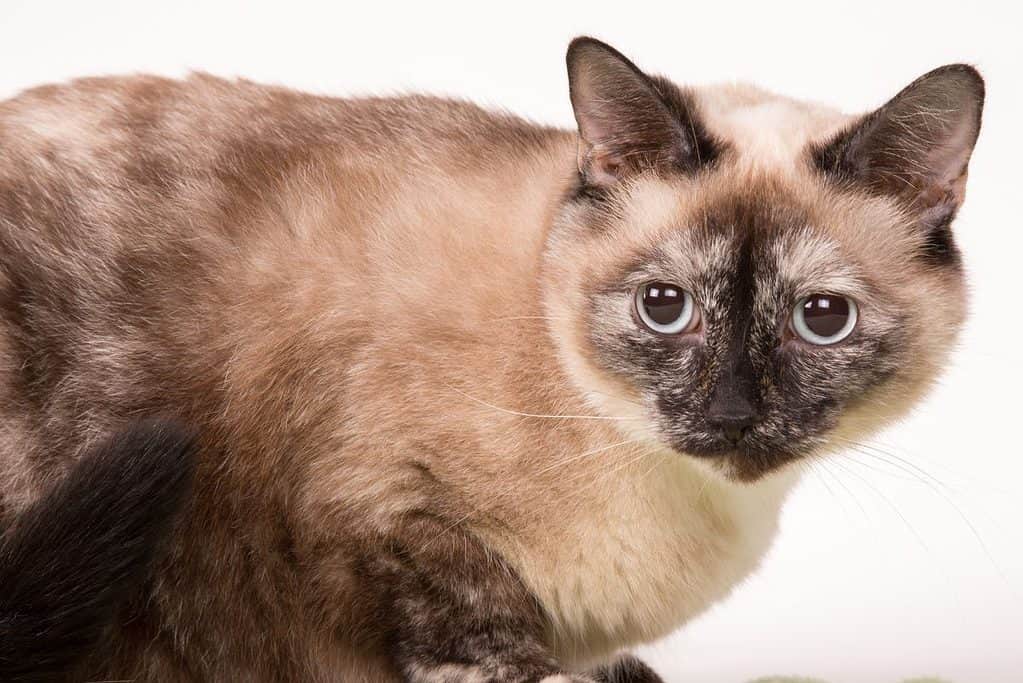When we adopted our cat as a three-month old kitten, her fur was 100% black. After our black cat grew into an adult cat, I noticed that she started sprouted white hair. At first, this white fur was just singular strands of fur that would pop up in various places around her body: one month it would be a single white fur on her shoulder and another month, there would be a single white fur on her chest.
As my black cat grew older, the number of white hairs on her black chest increased so that by the time she was six years old, she had a significant collection of them.
All cats can experience the growth of white fur but the change is most striking in dark colored cats like black cats. (Related: Two Things That Turn Black Cats’ Fur Red)

Let’s take a look at some of the reasons why black cats start growing white fur.
White fur develops with age
As it was the case with my cat, one of the most common reasons for black cats to start growing white fur is simply due to their age. Just like human hair can turn gray or white as we age, the same can happen to a cat’s fur.
As cats get older, their fur may start to turn white, especially around the face, paws, and chest. This process is known as graying, and it is a normal part of the aging process for cats.

Genetics can cause white fur growth
Another factor that can cause black cats to start growing white fur is genetics. Some cats may have a genetic predisposition to developing white fur as they age. This can be determined by a cat’s breed or family history.
For example, Siamese cats are known for their distinctive colorpoints, which are the dark-colored fur on their face, ears, paws, and tail. As Siamese and other colorpoint cats age, the points may turn white or lighten.

Hormonal changes
Hormonal changes in the body can also cause a change in fur color, leading to the appearance of white hairs. This can happen due to a variety of reasons, including changes in hormone levels that occur during pregnancy, aging, or illness.
Hormonal imbalances can also cause a cat’s fur to change color, so it’s important to consult with a veterinarian if you notice any sudden changes in your cat’s fur.
Health Issues
In some cases, certain health conditions can cause a change in fur color, leading to the appearance of white hairs.
For example, a condition called vitiligo can cause patches of white fur to appear on a cat’s coat. Vitiligo is a skin disorder that results in the loss of melanin, the pigment that gives color to the fur, skin, and eyes.
In addition to vitiligo, other health conditions such as thyroid problems can also cause a change in fur color.
Not all black cats will develop white fur
It’s important to note that not all black cats will develop white fur as they age. The extent and pattern of the color change can also vary between individual cats. Some cats may only have a few white hairs, while others may have a significant amount of white fur.
The speed at which a cat’s fur turns white can also vary, with some cats developing white fur slowly over time, while others may change more rapidly.
Change in fur color
While a change in fur color can be a normal part of the aging process for cats, it’s important to keep an eye out for any other changes in your cat’s health. In some cases, a change in fur color can be an indication of a more serious health issue, such as a thyroid problem or vitiligo.
If you notice any sudden changes in your cat’s fur color or if you’re concerned about your cat’s health, it’s always a good idea have your vet take a look at your cat.
In addition to checking for underlying health issues, it’s also important to maintain your cat’s overall health as they age. This includes providing a balanced diet, regular exercise, and annual veterinary check-ups.
Older cats may also require more specialized care and food to maintain a healthy coat.
Some health conditions will revert white fur back to black on a cat
This same black cat of mine developed feline acromegaly. Feline acromegaly is a rare condition where a benign tumor that presses against the pituitary glands. This conditions can often trigger uncontrolled diabetes and the standard treatment is targeted radiation (SRT treatment) on the tumor.
Since the tumor triggers the release of growth hormone, other symptoms of feline acromegaly include a growth in the cat’s organs, changes to the jaws, and an enlargement of the organs. One of the additional changes that I observed was a growth in the thickness of her coat as well as the disappearance of her white fur.







